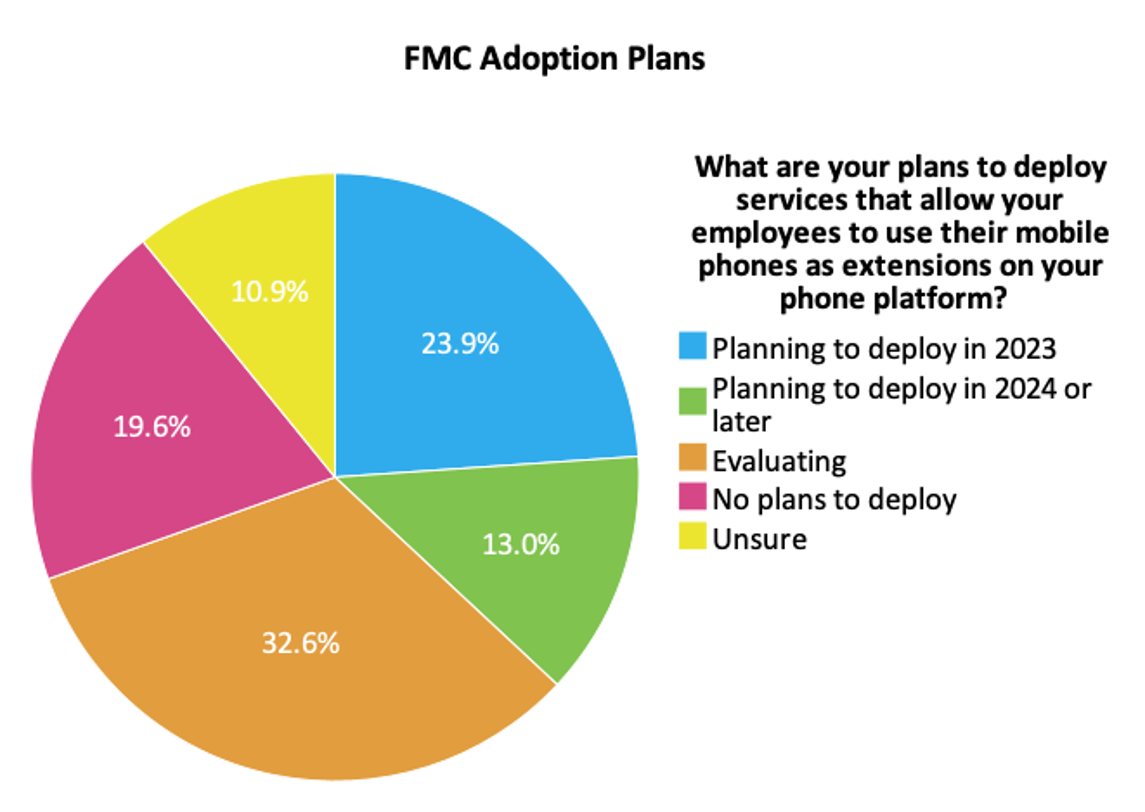Despite the growth and maturation of the unified communications market over the last several years one truth remains: employees still prefer the native app on their mobile phone for calling, across all use cases, compared to using mobile and desktop apps from their UC vendors.
Metrigy’s global Workplace Collaboration: 2023-24 study of 440 organizations, published in March of 2023, found that almost 12% of companies, mostly small businesses, had switched from a traditional business calling platform to simply allowing employees to use their own mobile phones, or the provisioning of company-owned mobile phones for calling.
The problem with this approach is that companies may lack control over phone numbers, the ability to integrate mobile calls with apps for customer relationship management, and the ability to enforce security and compliance controls on calls and messages. Last year, the SEC levied multibillion dollar fines financial services companies in the US for allowing customer communications without compliance controls, and the lack of employer ability to ensure industry compliance on employees' private devices shows the “BYOD” approach to mobile calling simply isn’t supportable.
Earlier research we conducted in 2021 found that only around 5% of companies who had provisioned mobile UC apps found that employees were using them for calling. Instead, mobile UC apps were primarily being used for messaging and for the joining of meetings when away from a desk. Clearly, there is a gap in user preferences when it comes to the available tools for business communications (such as a business calling platform) and the tools employees prefer (their own phones).
Our research also shows that demand for FMC is high, with almost 24% of our 440 research participants planning to deploy FMC solutions this year, and another 45.6% either planning a future deployment, or evaluating FMC for possible use.
Why Has Fixed Mobile Conversation Failed So Far?
The idea of fixed-mobile convergence – defined here as the integration of mobile phones and business calling platforms – has been around for a while. Early pioneers such as Ericsson and Tango Networks have had solutions available for years, however adoption has been limited, due to a combination of factors including solution complexity, cost, need for carrier investment, and lack of enterprise interest in FMC. Service providers like AT&T and Verizon have also sold mobile-first solutions for a while now, mostly focused at SMB customers with large numbers of field workers. For many, FMC simply meant the simultaneous ringing of their mobile phone when one received a call on their business line.
Other attempts at FMC included integrating mobile UC apps with mobile phone native dialers through capabilities provided by Android and Apple (e.g., Apple CallKit). These approaches allowed mobile users to initiate a call via their native dialer, and have that call routed through the mobile UC app on the phone, often a cumbersome approach that required placing a call over a data channel such as LTE or Wi-Fi, with variable sound quality. And, none of these approaches integrated with native messaging apps. The end result is that even though FMC solutions existed, their lack of usability translated into limited deployment.
The Next Generation of FMC has Arrived
In the nine months since I last wrote about FMC, solutions have continued to advance and expand. Today, leading options include:
- Cisco Webex Go, which uses an eSIM approach to configure Webex Calling phone numbers on mobile phones and to enable calling through the native dialer while also supporting a user’s personal identity on their phone.
- Microsoft Teams Phone Mobile, which allows provisioning of corporate-liable mobile phones as single-identity Microsoft Teams Phone extensions. Teams Phone Mobile is delivered in partnership with a limited number of carriers around the globe.
- Tango Extend, which is an eSIM solution for Microsoft Teams Phone that allows carriers to provision both Teams Phone and personal identities on mobile phones.
- Dstny Converge, which is another eSIM solution, but available for any UCaaS provider or service provider to add FMC capabilities their UC offerings.
In addition, in the US, AT&T, with Cisco, and Verizon, with Microsoft, have announced their own FMC offerings that offer additional features such as provisioning integration, unified voicemail and voice quality guarantees.
FMC Challenges Remain
As solutions increase and improve there are still a few limitations that may inhibit adoption:
- Availability: Availability of FMC solutions remains limited, though partnerships between carriers and UCaaS providers continue to expand.
- Cost: Solutions vary in terms of additional cost. Some require specific voice and data plans while others only add a fee for the FMC service on top of existing plans.
- Emergency Calling: Today, 911 calls from a FMC-provisioned device are handled by the mobile carrier the same way as they would handle a 911 call from a personal cell phone. However, the mobile carrier has no visibility into the location of the phone within a building and cannot provide on-site notification in accordance with Kari’s Law, or dispatchable location in accordance with RAY BAUMs Act. While every carrier I’ve spoken with has assured me that their FMC solution is compliant with applicable laws and regulations, I think it’s wise for organizations to consult their own counsel before deploying an FMC solution.
- Messaging: Today, none of the solutions offer SMS integration, meaning SMS still lives outside of the FMC solution though I expect SMS integration to be available in 2023 and 2024 on a carrier-by-carrier basis
Conclusion
True FMC is finally arriving from UC vendors and services providers. Today, easy to use solutions are available for Microsoft Teams Phone and Webex Calling. Given the interest in FMC, I expect other UCaaS providers to introduce their own FMC offerings as a way to fully integrate native dialers into their UC platforms. IT and business leaders should already be in conversation with their UCaaS and mobile providers to understand their roadmaps so they can plan for evaluation and deployment, and so that they can be ready to both provision and support FMC solutions. Do consult with appropriate legal counsel to ensure that deploying FMC solutions does not create additional liability related to location and onsite notification for emergency calling.
About Metrigy: Metrigy is an innovative research and advisory firm focusing on the rapidly changing areas of workplace collaboration, digital workplace, digital transformation, customer experience and employee experience—along with several related technologies. Metrigy delivers strategic guidance and informative content, backed by primary research metrics and analysis, for technology providers and enterprise organizations











